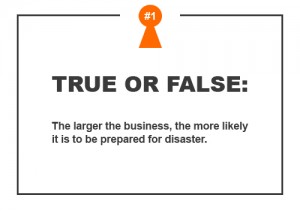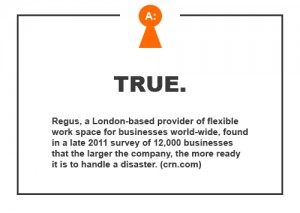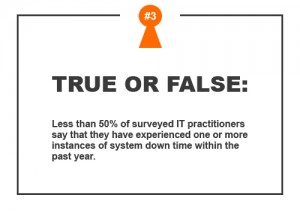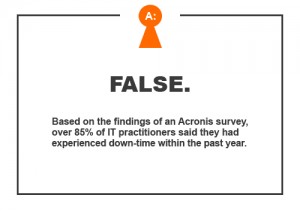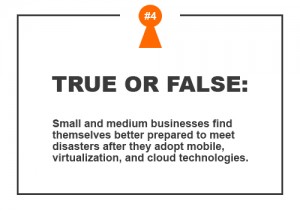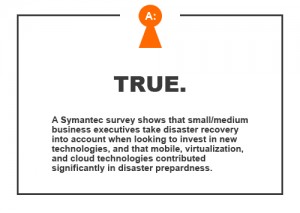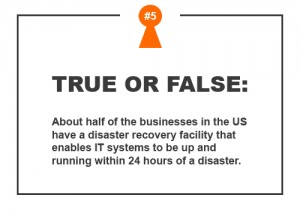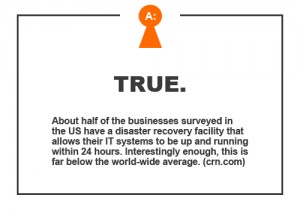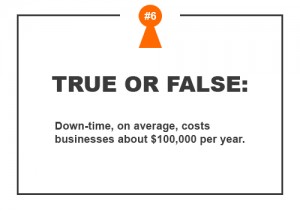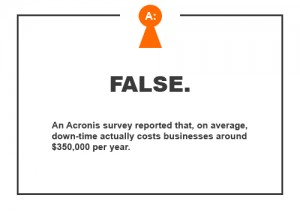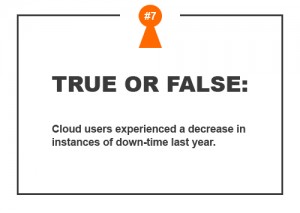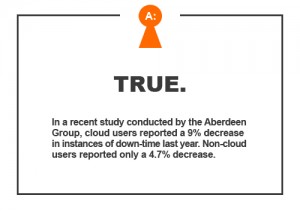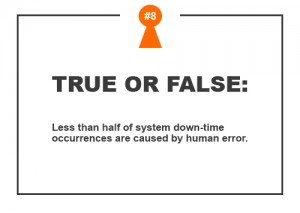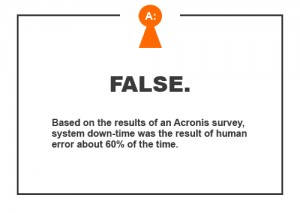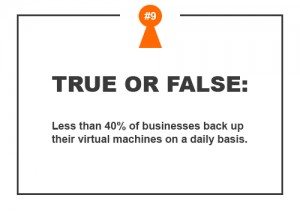Archive for March, 2013
The Disaster Recovery Trivia Challenge has a new home 2 comments
Hey there, everybody who has been playing our weekly Disaster Recovery Trivia Challenge! Hey, also, everybody who should be! If you’re confused, you should read this article, explaining what the Disaster Recovery Trivia Challenge is. Trust us, it’s not something you’ll want to miss out on. Especially if you like T-shirts and/or United States Dollars in quantities of one hundred.
Now that you’re up to speed and that we’ve gotten the more unfortunate news out of the way, we can proceed to the purpose of this article.
Our Disaster Recovery Trivia Challenge has been such a success, everyone! This is a fact that we are beyond psyched about. However, it’s outgrowing its home on our social sites faster than you can say “Disaster Recovery Trivia Challenge”, so we decided it’s time to relocate it to somewhere it has a little more room to breathe… like our blog, for example.
The game is the same in all other aspects; this is just a relocation of the weekly facts and answer reveals. You can still feel free to chat away on social media, since we–quite obviously–love to.
Here’s a round-up of what has happened so far:
And the winner is… BILL Y.!
And the winner is… NICK J.!
And the winner is… ALEX E.!
And the winner is… Russell G.!
And the winner is… Mike H.!
And the winner is… DARREN C.!
And the winner is… Empty Mirror Books!
Now that we are up to speed, here is this week’s TRUE or FALSE question:
So what do you think? Is it TRUE or FALSE? Tell us, and you could win a T-shirt and a shot at the grand prize of $100! You can post your guess here, or continue the conversation on our Facebook and Twitter pages. We don’t care how, we just want to give away T-shirts! Check back here later in the week to see if you’re our new winner! GOOD LUCK!
Even though the Disaster Recovery Trivia Challenge has a new home, you should still follow our social sites. We’re constantly on the look-out for share-worthy content on a vast array of super-cool topics–everything from hosting to gadgets to sustainability–and we’d love to hear your voice in the crowd.
Follow Us :Share :
CyberBunker vs. Spamhaus becomes CyberBunker vs. Internet 2 comments

If you are reading this article, chances are good that you have not been affected by what some are calling the “biggest attack ever” on the Internet… That, or you really like our blog and decided to wait for this page to load. Either way, let me tell you a little bit about what is happening!
According to sources such as The BBC and The New York Times, between March 15th and the 19th, a Dutch online hosting company, CyberBunker, began an all-out cyber-attack. This has affected the speed of the Internet for people globally. The attack began on Geneva-based spam-fighting group, Spamhaus, because of a supposed “black-listing”, and has even reached the United States.
CyberBunker, who is known for hosting anything that is not “child porn or terrorism-related,” was apparently added to Spamhaus’ list of companies who are said to distribute “spam”, in a wide variety of different ways, shapes, and forms. Because of CyberBunker’s lenient terms of services, Spamhaus believes that entities are able to flood the Internet with spam, without much difficulty.
CyberBunker—who, interestingly enough, is based out of an old military warfare bunker—retaliated with a Distributed Denial of Service, or a DDoS, and has flooded tons of traffic to Spamhaus’s Domain Name System (DNS). A DNS links websites’ domain names with their IP addresses, and while the attack is flooding their system, websites are globally becoming increasingly slow to get to. It has been said that these attacks have reached up to 300 GB per second, while most major attacks have been around 50 GB per second.
Netflix has seemed to be the largest company affected by this attack, but the Internet in general may be a little bit slower, mainly in Europe. While Spamhaus has over 80 servers all around the world, they have been able to fight this attack with the help of a few other companies—One of whom is Google, actually. While this is certainly not the end of the Internet, it has been the largest DDoS attack ever reported, and an issue that may become more of a concern to many large companies moving forward.
Follow Us :Share :
Alan’s Cloud Tip of the Month – March 2013 no comments
 Why move to the cloud? Here is March’s quick cloud tip:
Why move to the cloud? Here is March’s quick cloud tip:
Cloud technology optimizes existing resources…
Suppose your company is facing hard times in managing hardware and software. Let’s say your servers are running extremely low on space, and there is not enough room left for any new data to be stored. To overcome such a situation, cloud services can be employed. In turn, existing servers get a rest from the over-loaded traffic, and the work environment of the company becomes more synchronized.
Moving to the cloud optimizes your resources, but with the help of managed cloud services, businesses are able to focus time and attention on other business-related activities.
Follow Us :Share :
reCAPTCHA: digitizing the printed word, one spam filter at a time 7 comments
 In 2009, Google went from having around 20,000 employees, to having millions of people all over the world working for them. Well… sort of.
In 2009, Google went from having around 20,000 employees, to having millions of people all over the world working for them. Well… sort of.
You might already be familiar with what is pictured below. If not, let me explain to you a little bit about something that I was recently informed about –this magical thing called “reCAPTCHA”.
 In the year 2000, I was worried about passing the 4th grade. I was anticipating that all the computers in the world were going to explode due to Y2K. I was hoping that I could fend for my family and not die of Dysentery on The Oregon Trail. Needless to say, life was rough.
In the year 2000, I was worried about passing the 4th grade. I was anticipating that all the computers in the world were going to explode due to Y2K. I was hoping that I could fend for my family and not die of Dysentery on The Oregon Trail. Needless to say, life was rough.
But Yahoo!—and hundreds of other web companies, for that matter—were dealing with a much larger epidemic than Dysentery—spam. No, not that gross, canned mystery meat, and definitely not George Michael’s Wham! This kind of spam is something (debatably) worse than both… combined!
We’ve all encountered spam in our email inboxes, but now, thanks to Luis von Ahn, we also have all run into what is stopping most of it.
Luis von Ahn grew up in Guatemala and worked in his family’s candy shop as a kid. Later on in his life, along with his college advisor, he was hired by Yahoo! to create a program that could tell the difference between a human and a form bot. They came up with “CAPTCHA”, which—and I’m serious here—stands for “Completely Automated Public Turing test to tell Computers and Humans Apart.”
While the name isn’t exactly the work of genius, these brilliant guys created a challenge-response test that could be predominantly passed by humans to block those evil form bots and eliminate as much spam as possible. These computer-generated, squiggly words are made so humans can read and submit them, but that computers cannot.
After becoming extraordinarily successful off this creation, Mr. von Ahn still found a weakness in his own program. The flaw? The 10 annoying seconds wasted while someone types in a CAPTCHA every time they come across one. After turning down a personal offer from Bill Gates to work for Microsoft and winning the MacArthur Fellowship Award in 2006, von Ahn re-created CAPTCHA and titled it…erm… reCAPTCHA! Luis von Ahn believed this new idea would be good for humanity, and as far as some other types of crowdsourcing go, I agree.
In 2009, Google bought reCAPTCHA and released it upon the masses. Now, what reCAPTCHA does is take the words we type in and use them to digitize old books and newspapers. These books and newspapers are scanned and turned into text-images by using “Optical Character Recognition” (OCR). The problem remains that computers still cannot read text as well as humans. A simple word like “of” could be interpreted as “at,” since old books and newspapers may have words that are damaged or hard to scan.
Here is where the superpower of humans comes in! We can read the word “of” and correctly submit “of,” instead of “at”, along with a computer-generated CAPTCHA word. So a reCAPTCHA image is combined with a CAPTCHA word, and placed at the login of something like an email. If we get the CAPTCHA word correct, we are in-there-like-swimwear. Even if we get the reCAPTCHA wrong and cannot decipher it ourselves, but get the CAPTCHA, we are still allowed access. The reCAPTCHA word will be tested by many other humans to increase the likelihood of it being deciphered correctly.
Using the aforementioned example of the word “of” being read as “at”, if people keep typing “of”, the word “of” will digitally replace the word that the OCR program recommended. After some time, millions of people are deciphering these scanned reCAPTCHA words and creating digitized versions of old New York Times newspapers and classic books for Google!
In months, with the power of reCAPTCHA and humans’ ability to read damaged words, 20 years’ worth of material is digitized and transcribed thanks to… well… you…me… Alan Rosenberg… maybe Luis von Ahn and Bill Gates… your mom? Everyone! In time, thanks to Luis von Ahn and his team, we will all be a part of digitizing millions of old texts to be distributed online. Now, where are our paychecks, Google?
Follow Us :Share :
Laptop vs. Tablet: A Technical Dilemma 2 comments
It’s your favorite technician, back again, with another piece of knowledge from my heart to yours. Well, that’s a bit misleading, as I actually need your help.
You see, not too long ago, my girlfriend and I drove down to good ol’ Georgia to spend Christmas with my family. This was the first time that my girlfriend spent with my family. Yeah, we’ve been dating for 2-years-plus and this was her first time meeting them. Well, let’s fast forward a bit here in the story. She met the family and everyone loved her, as expected. Now, this is a rather long drive to make from New York to Georgia. It actually took us about 16 hours. Not too bad, especially when you have some technology to keep you entertained.
What do you pack for technology on a trip? For us, it was:
1. Cellphone (x2)
2. Cellphone charger
3. Laptop (x2)
You might think we should have brought a GPS, but we both have Samsung Galaxy 3’s, so we didn’t need one.
Let’s jump ahead again to the drive back up to New York after a GREAT few days in Georgia. This is where things got interesting. On the way back, we placed one of our laptops on the back seat. At one point, we had to hit our brakes pretty hard…as there are people who can’t drive safely…and the laptop flew under the seat. Now, this wouldn’t be that big of deal, unless you add in a wet carpet from water leaking into the car. Well, as anyone out there may know…
Laptop + water = water damage.
We were hoping and praying that the laptop would be fine. That by some miracle, the laptop—let’s call her “Lappy”—would be OK. Well, this wasn’t exactly the case. When we booted it on, the video display wouldn’t even display anything. I knew Lappy was still online, but we couldn’t access her. Since I’m a slayer of tickets, fighting for top-notch customer support for every Turnkey Client, I knew the video card was now damaged. This put me in quite a conundrum:
1. Replace the laptop?
2. Replace the motherboard?
3. Purchase a tablet to replace the laptop?
Option 1 and option 2 are very similar. If I replace the laptop, it would essentially be the same as replacing the motherboard, and the cost would be just about equal. Enter: Option 3; purchase a tablet to replace the laptop. Now, this seems like a good option. I’ve been considering a tablet purchase for months, and what better time to get one than when your laptop dies because your carpet is too wet? Before I make such financial decisions, I like to look at the pros and cons. Here is a list of some of the pros and cons I’ve developed for this particular situation:
Pros:
• Upgraded version from broken laptop (bought said laptop in 2007)
• Greater mobility
• Increased computing power (over old laptop)
• Touch screen
• Pricing
Cons:
• No physical keyboard to do work from home
• Easier to break (moving it a lot more than a laptop)
• Inability to run work-related software (like VPN, for instance)
Based off that information, I feel that the best option may be to go with purchasing a new laptop. I would still be able to use a lot of my work software that I’m not sure would work on a tablet, and that’s important. On the other hand, I could just buy the tablet and drive into the office to do any other work, which wouldn’t be too much trouble for someone who lives only 10 minutes away. Looks like I still have some thinking to do…
This isn’t a typical blog post, but we’re not a typical hosting company.
Any suggestions?
Follow Us :
Share :

